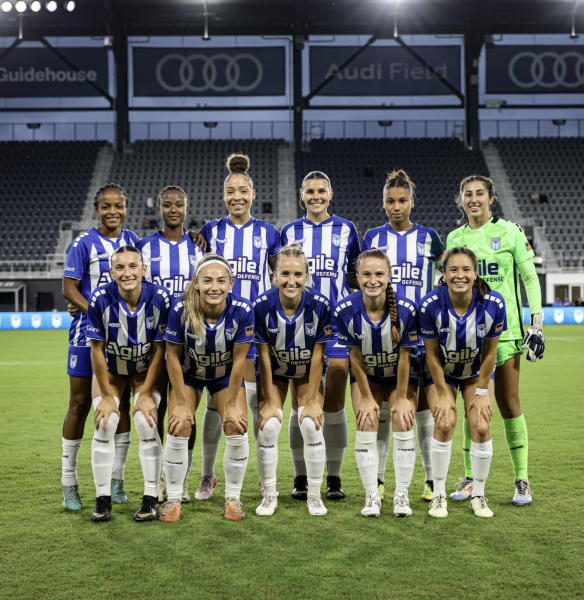Soccer is an integral part of Washington, D.C.’s identity. Not only does the city have a vast youth soccer infrastructure, it also boasts two established professional teams: D.C. United and the Washington Spirit. This fall, however, a new team — D.C. Power FC — decided to throw its hat into the ring, joining the local soccer landscape as part of a new professional women’s league, the USL Super League (USLS).
Power FC is one of eight clubs competing in the inaugural season of the USLS, a Division 1 professional women’s soccer league organized by United Soccer League (USL). Most people are more familiar with the National Women’s Soccer League (NWSL), the longest-standing and premier women’s professional league in the United States. The NWSL also holds Division 1 status granted by the United States Soccer Federation (USSF).
This granting of Division 1 status is something of slight controversy in the U.S. soccer landscape. Unlike most countries that use a system of promotion and relegation — where professional leagues form a pyramid with a single “Division 1” at the top — USSF follows the structure typical of other U.S. sports leagues, such as the National Football League (NFL) and the National Basketball Association (NBA).
In the case of men’s soccer, Major League Soccer (MLS) is the only league with Division 1 sanctioning from USSF, while the USL Championship (USLC), has Division 2 sanctioning. Therefore, the granting of Division 1 status for the USLS marks the first time that two competing leagues have both received Division 1 sanctioning. Although USLS now theoretically has the same standing as the NWSL, it remains to be seen whether or not the new league will be able to achieve the prestige and quality of play of the NWSL.
The USLS launched its 2024-25 season this August, notably adopting a fall-spring schedule. While most soccer leagues worldwide also operate from fall to spring, all other U.S. leagues — including the NWSL — run from spring to fall.
There are several possible reasons for this departure from the norm. For one, aligning offseasons (and therefore transfer windows) with the European calendar permits greater engagement with the international transfer market and allows USLS clubs to bring in more overseas players. Additionally, it allows players to participate in full with their respective national teams without missing time with their clubs.
Another possible reason? In minimizing overlap with other North American leagues, the USLS might seek to increase its engagement and attendance. Being the only league playing through the winter, the USLS has a unique opportunity to attract loyal U.S. soccer fans who might otherwise attend games in other leagues.

Currently, the USLS houses teams in Charlotte, N.C.; Brooklyn, N.Y.; Fort Lauderdale, Fla.; Tampa, Fla.; Spokane, Wash.; Dallas, Texas; Lexington, Ky.; and D.C. Each team plays every other team four times in total, twice in the first half of the season and twice in the second. The top four teams will then proceed to a playoff tournament, the winner of which will be named the season’s champion. Currently, eight more cities are expected to add teams for the 2025-26 season — Indianapolis, Ind.; Jacksonville, Fla.; Madison, Wisc.; and Palm Beach, Fla.
So, what does D.C. Power FC look like right now? Its core ownership group consists of several prominent athletics investors in the Washington, D.C.-Maryland-Virginia area, including Jordan Stuart, a minority owner of Loudoun United FC, Devin Talbott, part owner of D.C. United and star WNBA player Angel Reese, a DMV native herself.
The team announced Frédéric Brillant as their inaugural head coach May 20. Brillant, a former French player who spent most of his professional career in Belgium and the U.S., played for D.C. United from 2018 to 2022. As a former assistant coach for D.C. United in 2022, his DMV roots run even deeper.
Power FC plays at Audi Field, just as D.C. United and the Washington Spirit do. With the exposure to a pre-existing fanbase and popular stadium, the team will hopefully have the opportunity to draw out even more fans. Adding to their local appeal, Power FC’s roster contains a plethora of DMV natives — 13 of the club’s 26 rostered players. They provide a promising prospect to help build a stronger pipeline of girls’ youth soccer in the area.
Currently, D.C. Power FC sit seventh in the standings after seven games, and have yet to pick up their first win. However, the season has a long way to go, and plenty of time to work out any kinks. Power FC will play their next game against Brooklyn FC Oct. 11 at 7:30 p.m. and will host Dallas Trinity FC at Audi Field Oct. 16 at 7:30 p.m. With the strong foundation of DMV soccer already in place, D.C. Power FC has a promising future ahead of it.